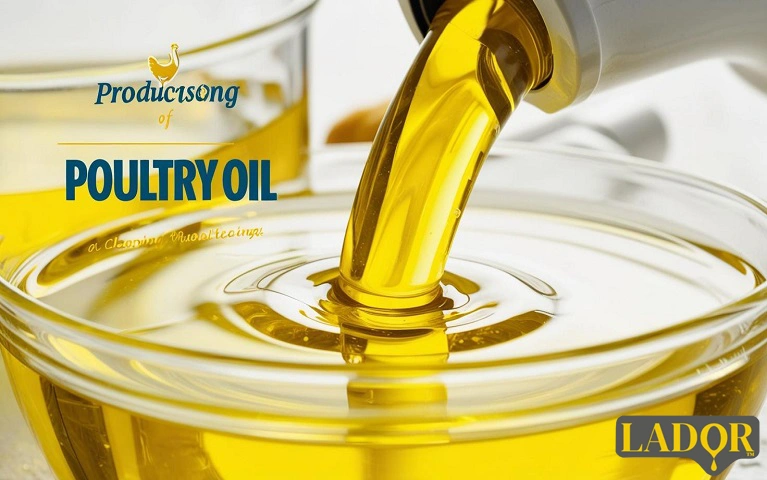Crude poultry oil or animal fat is a significant source of energy for poultry and is widely used in their feed. This oil is derived from fats extracted from the fatty tissues of animals (such as chickens, cows, and sheep). In the following, we will examine raw poultry oil .
Composition of Crude Pou ltry Oil
- Fatty Acids: Crude poultry oil contains various fatty acids that vary depending on the type of poultry and their diet. These fatty acids include saturated, unsaturated, and polyunsaturated fatty acids such as omega-3 and omega-6.
- Glycerides: Glycerides comprise the main part of the oil and are formed by combining glycerol with three fatty acids.
- Vitamins: Crude poultry oil contains fat-soluble vitamins such as A, D, and E.
- Minerals: This oil contains small amounts of minerals such as calcium, phosphorus, and iron.
- Other Compounds: Crude poultry oil may contain small amounts of other compounds such as sterols, carotenoids, and antioxidants.
Nutritional Value of Raw poultry oil
- Crude poultry oil is a rich source of energy and can help provide the energy needed by poultry.
- Essential fatty acids such as omega-3 and omega-6 are present in crude poultry oil and are necessary for the growth and health of poultry.
- Vitamins A, D, and E found in crude poultry oil are essential for growth, immune system strengthening, and bone health in poultry.
Production Method of Crude Poultry Oil
Crude poultry oil is usually obtained by two methods:
Solvent Extraction
In this method, chemical solvents are used to extract oil from the fatty tissues of poultry. This method has a high yield, but it may cause a small amount of solvent to remain in the oil.
Mechanical Extraction
In this method, pressure and heat are used to extract oil from the fatty tissues of poultry. This method is safer but has a lower yield.

Advantages of Raw poultry oil
- High Energy Source: Crude poultry oil contains a large amount of energy that helps poultry meet their energy needs for growth, egg production, and other physiological activities.
- Absorption of Fat-Soluble Vitamins: This oil helps absorb fat-soluble vitamins (such as vitamins A, D, E, and K), which are essential for the health and better performance of poultry.
- Improved Taste and Texture of Feed: Adding crude poultry oil to poultry feed can improve its taste and texture and increase feed consumption by birds.
- Reduction of Feed Dust: raw poultry oil can help reduce feed dust, which can help improve the respiratory health of poultry and reduce related problems.
- Cheap and Available: Compared to some vegetable oils, crude poultry oil is usually cheaper and more readily available.
Disadvantages of Crude Poultry Oil
- High Saturated Fat Content: This oil usually contains a high amount of saturated fat, and excessive consumption of it can be harmful to the health of poultry and lead to problems such as obesity and heart disease.
- Quality Fluctuations: The quality of crude poultry oil can vary depending on its source and production method. Some oils may contain a large amount of free fatty acids or other undesirable compounds.
- Storage Problems: This oil must be stored in suitable conditions to prevent its spoilage and oxidation.
General Applications of Crude Poultry Oil
- Feeding Broiler Chickens: Crude poultry oil is widely used in feeding broiler chickens to increase weight and improve meat quality.
- Feeding Laying Hens: This oil can help improve egg production and its quality in laying hens.
- Production of Poultry Feed: Crude poultry oil is used as one of the main components in the production of poultry feed.
Reasons for Superiority Over Other Oils
- Reasonable Price: Crude poultry oil is usually cheaper than vegetable oils such as soybean oil or sunflower oil.
- High Availability: This oil is readily available in many regions.
- High Energy: Crude poultry oil contains a large amount of energy, which is very beneficial for poultry.

Important Points Regarding Crude Poultry Oil
- When using crude poultry oil in poultry feed, attention should be paid to the amount of consumption, and excessive consumption should be avoided.
- To ensure the quality of the oil, it is better to obtain it from reputable sources.
- This oil should be stored in suitable conditions away from direct sunlight and moisture.
Conclusion
Crude poultry oil is a rich source of energy and essential fatty acids for poultry. This oil contains compounds such as fatty acids, glycerides, fat-soluble vitamins, and minerals that help the growth, health, and reproduction of poultry. This oil is usually obtained from the fatty tissues of poultry through solvent extraction or mechanical extraction. However, due to the presence of impurities and odor, it is not suitable for direct human consumption and must be refined.
A’la Oil Sepahan Factory, under the trade name Ladorfat, is active in the production of various types of poultry and industrial powder and oil. For more information, contact Ladorfat Consultants.



